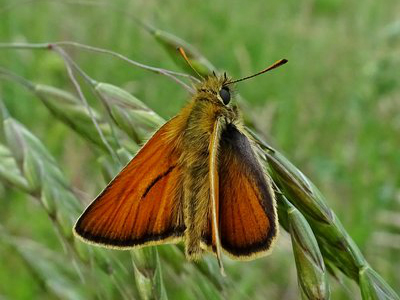
| Butterfly Conservation |
 |
| Hertfordshire & Middlesex Branch |
 |
|
|||
| Saving butterflies, moths and our environment | ||||

_DSC_0367_28June16_SCPtn-2.jpg)
Small SkipperThymelicus sylvestrisWidespread but declining resident Distribution and Status Like the Essex Skipper, there has been a decline in the Small Skipper since the 1980s but the decline is not as steep. Quite a few colonies have disappeared in arable north-east Hertfordshire since the start of the century while new ones found in south-west Middlesex. Loss of suitable habitat is the likely cause for the decline but lack of nectar may also be a factor as females emerge with immature eggs. Nectar sources are very important for food to increase their reproductive potential (Field et al.). New-found populations in Middlesex may be attributed to increased recorder effort Habitat Requirements Rough grassland, where grasses are left to grow, in fields, roadside verges and edges of woodland Larval Foodplants Yorkshire Fog Holcus lanatus but Timothy Phleum pratense, Creeping Soft-grass Holcus mollis and False Brome Brachypodium sylvaticum are also occasionally taken Adult Food Sources Thistle Cirsium sp., Common Bird's-foot Trefoil Lotus corniculatus, Common Knapweed Centaurea nigra Behaviour/Observation notes Because of the confusion between this species and the Essex Skipper the best time to positively identify which one is either in cloudy weather or in the evening when the butterflies are less active. Early in the morning is also another good time to look for these skippers as they are often found feeding on flower-heads. Approaching them at rest or feeding should then be far easier to get close-up views of the antennae, a distinguishing feature. Differences are explained in the account for the Essex Skipper Life History There is only one generation of this butterfly. Adults emerge from the middle of June but the vast majority are on the wing in July although some will linger beyond the middle of August. Several eggs are laid in the sheaths of grasses. The larvae on emerging construct a silk cocoon still within the sheath of grass and hibernate in this chamber. In the following spring the larvae emerge from the cocoons and feed on the grass blades. When fully grown, a tent is spun using the grass blades within which a pupa is formed Further information
Identifying Skippers References
Field, R.G, Watkins, G. and Gardiner, T. (2005), The Use of Countryside Stewardship Scheme Field Margins by the Small Skipper Thymelicus sylvestris, Essex Skipper Thymelicus lineola and Large Skipper Ochlodes venata, The Entomologist's Record and Journal of Variation, Vol 117 Pt 5 pp. 197-203 |
Copyright Butterfly Conservation © 2019 Hertfordshire & Middlesex Branch
Privacy and Copyright Statement and Cookie Policy Statement
Butterfly Conservation
Company limited by guarantee, registered in England (2206468)
Registered Office: Manor Yard, East Lulworth, Wareham, Dorset, BH20 5QP. Tel: 01929 400 209
Charity registered in England & Wales (254937) and in Scotland (SCO39268). VAT No. GB 991 2771 89